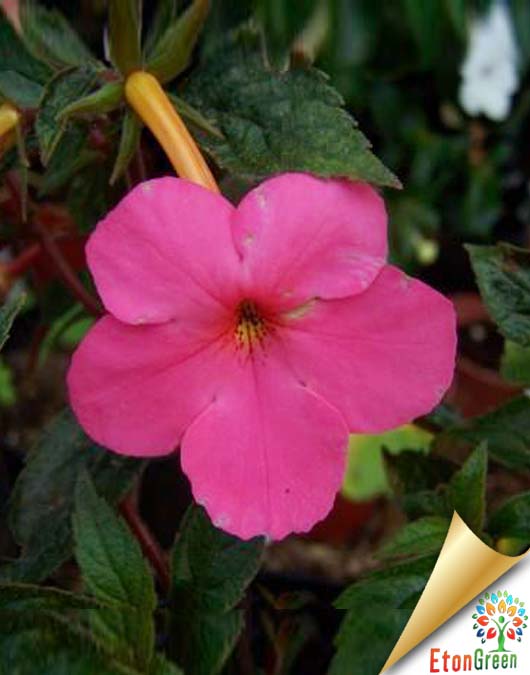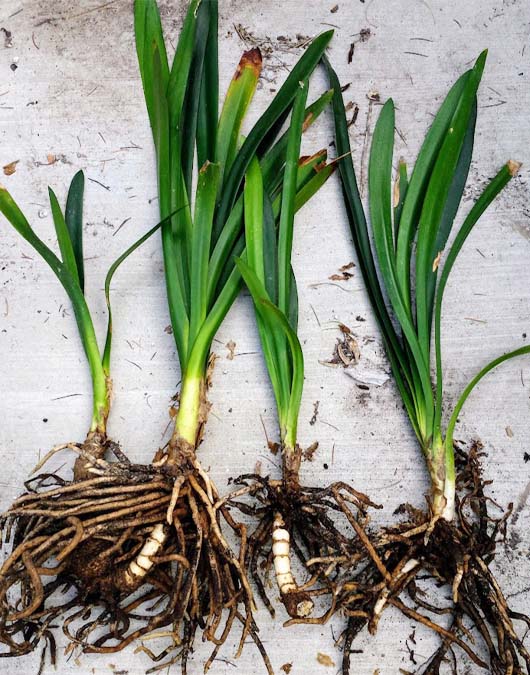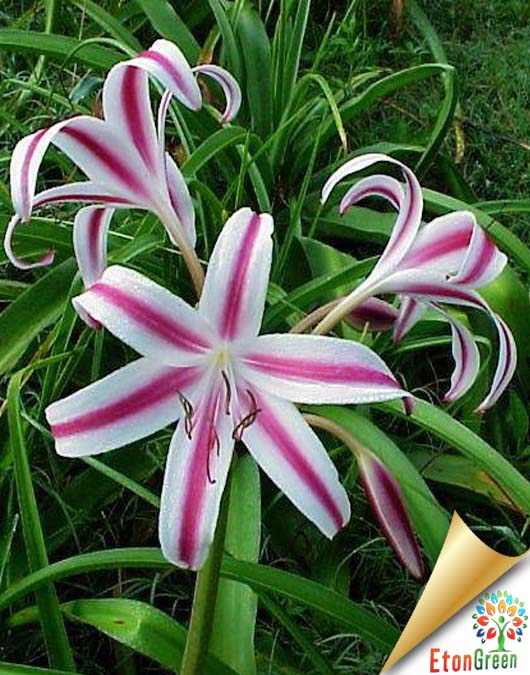- Shipping charge ₹ 90 for entire order
- Achimenes mexicana is a beautiful and easy member of the Gesneriad family that grows from curious elongated scaly rhizomes.
- It has gorgeous blue-purple flowers with a white throat. They are funnel-shaped and the colour is quite hard to capture photographically as in different lights they appear to oscillate between purple-blue and blue-purple.
- It should come as no surprise that this variety is a favorite among many for its high bloom count and solid, rich coloring. An excellent partner for white tuberous Begonias, these two create a gloriously contrasting display. Provide these easy growers with protection from the sun and regular water during active growth, and they’ll return the favor with months of bright blooms! Enjoy!
- Shipping charge ₹ 90 for entire order
- This beautiful bloomer is grown mostly as a flowering houseplant in hanging baskets or mixed containers. As relatives of African Violets, Achimenes fancy more moderate conditions than most outdoor settings provide. They grow best in areas with light to partial shade or dappled sun.
- Choose a spot where your Achimenes will receive light to moderate shade or dappled sun.
- Select a container with at least one drainage hole and fill it with a good quality, well-draining soil. Almost any commercially available potting mix will do the trick.
- Dig small holes and nestle the bulbs 3/4”–1” deep and 3”–4” apart. Don’t worry about which side is up, as they will happily grow from any position.
- Shipping charge ₹ 90 for entire order
- These plants are perennial herbaceous bulbous plants. They generally have large fleshy bulbs. It is a plant with strap-shaped, glossy, green leaves and producing few large funnel-shaped flowers on a stout stalk, from March-May This plant is very suitable for planting in border, shrubbery and in a pot.
- The amaryllis lily is mainly used for ornamental purpose in garden, terrace, balcony, patio, etc.
- Common name: Hippeastrum
Color: The usual color is white with crimson veins, but pink or purple also occur naturally.
Bloom time: Late December until the end of June.
Height: 24 in/60 cm.
Difficulty level: EasyPlanting & Care
Amaryllis like their soil rich, but exceptionally well-drained, so ideally create a mix from one part well-rotted manure, one part horticultural grit or sand, and two parts leaf mould. Two-thirds good compost mixed with one-third grit also does fine.Sunlight: Full sunSoil: Well-drained soil.
Water: Keep soil moist throughout the growing season.
Temperature: 20°C
Fertilizer: Apply any organic fertilizer.
Harvesting: After the amaryllis has stopped flowering, it can be made to flower again. Cut the old flowers from the stem after flowering, and when the stem starts to sag, cut it back to the top of the bulb. Continue to water and fertilize as normal all summer, or for at least 5-6 months, allowing the leaves to fully develop and grow. When the leaves begin to yellow, which normally occurs in the early fall, cut the leaves back to about 2 inches from the top of the bulb and remove the bulb from the soil. Clean the bulb and place it in a cool (40-50 deg. F), dark place such as the crisper of your refrigerator for a minimum of 6 weeks. Caution: Do not store amaryllis bulbs in a refrigerator that contains apples, this will sterilize the bulbs. Store the bulbs for a minimum of 6 weeks.
Care:
- Once the plant is flowering, continue the watering and keep it out of direct sunlight, and slightly cooler (10-15°C), but as light as possible to promote a longer flower life.
- Each individual flower should last two or even three weeks before they brown.
- As each one fades, cut it off at the top of the stalk and then when the whole stalk is over and begins to sag, carefully cut it off just above the bulb nose.
- After flowering you can keep them from one year to the next.
- Feeding needs to continue and you want to water too, until the leaves begin to yellow in late summer/early autumn.
- At this stage, cut the leaves back to about 6cm (2½in) from the top of the bulb and remove it from the pot.
- Keep the bulb cool (5-10°C) and dark, to give it a dormant period for 8 weeks before you can encourage it to come into leaf and flower again When the temperature in your greenhouse falls to below 10C, bring them into the warmth and begin gentle watering again and your bulb will re-shoot.
- Don t re-pot it for the first couple of years; it hates root disturbance.
- The older and bigger the bulb, the more flowering stems you’ll get, so it’s worth the trouble of nurturing these mini football bulbs.
- Bulbs older than two years will produce offset bulblets.
- These may be left attached to the mother and re-potted with her, creating an amazing show, but its best to remove them carefully just before you replant and put them in their own individual pots.
- These little bulbs will take two years before producing their first flower, but it will be a proud moment when they do.
- Shipping charge ₹ 90 for Entire order.
- Anemone flower can beautify every place with its simplicity and beautiful scent.
- Anemone is perennial flowering plant that have basal leaves with long leaf-stems that can be upright or prostrate. Anemone flower is a plant that can be increasingly found in gardens and terraces. This beautiful flower can beautify every place with its simplicity and beautiful scent.
-
Besides being the most common gift to give to someone, flowers are also beautiful decoration and important ingredients of perfumes and many other things that make our lives more beautiful.
Common Name Anemone or Windflowers Height Up to 2 to 3 feet Flower Colour Random color Bloom Time Spring Difficulty Level Easy to grow - Special Care For Anemone.
- Before Planting : Deep The Bulb into Normal water during 30 Minutes to 45 Minutes.
- Soil: Mix The normal Soil with 30% of Coco Peat & 20% of Vermi Compost ,
- Planting : Bulb is already Medicine Treated , Plant the bulb in Pot One inch deep. There is no need of Water till Germination or a week.
- Shipping charge ₹ 90 for entire order
- Is it a bulb? Is it a root? No, it’s a begonia—technically a “tuber”—that produces some of the most brilliant blooms in any late-season garden! A very versatile and colorful species, Begonias can be planted in pots, window boxes, the ground, or just about anywhere in either sun or shade.
- Tuberous begonias are popular all over the world. Not only do they have attractive flowers, but their foliage can be quite interesting, too. They can brighten up both your indoor and outdoor gardens.
- Begonia Tuberous Double make your garden look very beautiful as they start blooming in month April. The utterly captivating fragrance of fresh Begonia is hard to beat in a garden.
- Simply plant the bulbs 20cm deep and wait for these lovely Summer blooming perennials to give you a pleasing look.
- Well drained – light, sandy, clay- heavy, moist chalky, alkaline, acidic soil.
- Shipping charge ₹ 90 for entire order
- Its flowers are red, orange or yellow, sometimes with a faint, but very sweet perfume.
- Clivias are herbaceous plants with long, slender green leaves. The flowers, which can be yellow, orange or red, grow as individual blooms on the tip of an umbel, which stands as a hardy stalk above the green foliage below.
- These flowers have a bell shape to them and make for beautiful additions to a flower arrangement. Clivias do not form bulbs, but they do produce berries as fruits. It grows to a height of about 45 cm (18 in), and flowers are red, orange or yellow, sometimes with a faint, but very sweet perfume. It is sometimes known in cultivation as “Kaffir lily” (a term considered offensive in South Africa). The same name is also applied to the genus Hesperantha. It contains small amounts of lycorine, making it poisonous.
-
Sunlight These plants do best as part-time outdoor plants, spending the summers outside in a shady spot with no direct sunlight. Bring them in during the winter rest period and keep in a lit but cool location. Watering Suspend water during the winter and resume again in the late winter or early spring. Soil A standard potting mix should be fine. Temperature With a minimum temperature of 10 C (50 F) Fertilizer During the growing season, fertilize every week with a weak liquid fertilizer. It also works to include controlled-release fertilizer pellets in the soil.
Clivia is the ideal plant for the shade garden or for containers. It purifies the air.
- One adult plant can absorb one liter of impure air and release 80% of oxygen overnight
- It performs photosynthesis under very weak light
- 3-4 plants are enough in a room for absorbing smoke and other contaminants
Caution
All parts of the plant are slightly poisonous. Hence, the pot should never be placed within reach of small children and pets.
- Shipping charge ₹ 90 for entire order
- Crinum lilies are large, heat and moisture loving plants, producing an abundant array of showy flowers in summer.
- Lilly like their soil rich, but exceptionally well-drained, so ideally create a mix from one part well-rotted manure, one part horticultural grit or sand, and two parts leaf mould. Two-thirds good compost mixed with one-third grit also does fine.
-
Crinum Planting Procedure:
- Each bulb needs to be planted right side up
- The more pointed end is considered the top
- Plant each bulb in a hole that is just deep enough that its neck is protruding from the soil and the bottom of the bulb is covered in soil
- Covering the entire bulb with soil and planting too deep discourages flowering
- Space bulbs at least 8 inches apart and water the planting site or container well after planting
- Plant the bulb, or place the potted bulb in a warm place with direct light since heat is necessary for the development of the stems.
- Shipping charge ₹ 90 for entire order
- Despite its name, it is not related to the tulip, but to the various ginger species such as turmeric. It can grow as an indoor plant and is also sold as a cut flower.
- Inflorescences, stems, and leaves of this plant resemble the flowers, stems, and leaves of tulips, hence the common name. The true flowers are seen only if they curl around the bracts edges.
- Each inflorescence appears atop a rigid, reed-like stem that grows to 2 inches tall from a clump of narrow, lance-shaped, dark green leaves.
-
Curcuma Planting Procedure:
- Plant rhizomes in spring after last frost date in organically rich, medium moisture, well-drained soils in full sun to part shade
- Plant rhizomes outdoors in spring
- Plant them at a depth of 4 inches
- Plants may also be grown in containers that should be overwintered indoors in the pots in a cool dry location with minimal moisture
-
Caring for Curcuma
- Prepare your planting site, which should be in full sun. Till in a several inches of organic matter, such as peat moss or course sand, to the 12 inches of your planting site to make your soil better suited for drainage. Plant curcumas about one per square foot and bury the bulbs only an inch from the surface of the soil. The eye–or bud–should be facing up .Push down on the soil with your hands to remove any possible air pockets. Water the bulbs and after the water seeps into the soil, push down the soil again.Fertilize curcuma bulbs after planting. Use about one tablespoon of fertilizer labeled 15-15-15 (or 16-16-16 for large curcuma) and a bit less for small varieties
- If your soil tends to dry out much, it’s best to grow Curcuma in partial shade.
- Provide regular moisture throughout the growing season and do not allow soils to dry out.


















